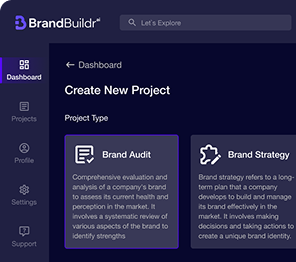Der Finanzdienstleistungssektor hat sich aufgrund des raschen technologischen Fortschritts erheblich verändert. Die digitale Transformation, ein Prozess, bei dem digitale Technologien genutzt werden, um neue — oder bestehende — Geschäftsprozesse, Unternehmenskultur und Kundenerlebnisse zu entwickeln — verändert die Finanzbranche grundlegend. Für traditionelle Finanzinstitute wie Banken, Versicherungsunternehmen und Kreditgenossenschaften hat die digitale Transformation sowohl Herausforderungen als auch Chancen mit sich gebracht.
Dieser Artikel untersucht die Auswirkungen der digitalen Transformation auf traditionelle Finanzinstitute und beleuchtet die Wachstumschancen, die Risiken, ins Hintertreffen zu geraten, und Strategien für eine erfolgreiche Umsetzung.
%20(1).avif)
1. Sich ändernde Kundenerwartungen
Die Nachfrage nach Komfort und Geschwindigkeit
Die digitale Transformation hat die Kundenerwartungen in allen Sektoren erhöht, insbesondere im Finanzdienstleistungssektor. Die Kunden von heute verlangen nahtlose, schnelle und personalisierte Dienstleistungen. Angesichts des Aufstiegs von Fintech-Unternehmen, die digitale Lösungen anbieten, sind traditionelle Finanzinstitute gezwungen, die Art und Weise, wie sie mit ihren Kunden interagieren, zu überdenken. Verbraucher erwarten heute Mobile Banking, sofortige Zahlungen und personalisierte Finanzprodukte, die auf ihre Bedürfnisse zugeschnitten sind.
Für traditionelle Banken erfordert die Erfüllung dieser Erwartungen mehr als nur die Digitalisierung ihrer Dienstleistungen. Es geht darum, die gesamte Kundenreise zu überdenken und ein konsistentes, qualitativ hochwertiges Erlebnis an allen Kontaktpunkten sicherzustellen — ob online oder offline.
Personalisierung und kundenorientierte Modelle
Die digitale Transformation ermöglicht es Finanzinstituten, riesige Datenmengen über das Verhalten und die Präferenzen von Kunden zu sammeln und zu analysieren. Mithilfe von KI und maschinellem Lernen können Banken hochgradig personalisierte Dienstleistungen und Produkte anbieten, von maßgeschneiderten Kreditangeboten bis hin zu maßgeschneiderter Finanzberatung. Dieses Maß an Personalisierung ist entscheidend, um bestehende Kunden zu binden und neue zu gewinnen, da moderne Verbraucher Unternehmen schätzen, die ihre individuellen Bedürfnisse verstehen und auf sie eingehen.

2. Verbesserte betriebliche Effizienz
Automatisierung und KI-Integration
Einer der wichtigsten Vorteile der digitalen Transformation für traditionelle Finanzinstitute ist das Potenzial für eine höhere betriebliche Effizienz. Automatisierungstools, die auf künstlicher Intelligenz (KI) und maschinellem Lernen (ML) basieren, können Routineaufgaben wie Kreditgenehmigungen, Compliance-Prüfungen und Kundendienstanfragen erledigen, sodass menschliche Mitarbeiter sich komplexeren Aufgaben widmen können.
Durch die Automatisierung von Backoffice-Prozessen können Banken Kosten senken, menschliche Fehler vermeiden und Abläufe beschleunigen. Beispielsweise kann die robotergestützte Prozessautomatisierung (RPA) Aufgaben wie Dateneingabe und Kontoabgleich viel schneller und genauer erledigen als ein Mensch. KI-Chatbots können Kundenanfragen rund um die Uhr bearbeiten und so den Kundenservice und die Kundenzufriedenheit verbessern.
Optimierte Prozesse
Digitale Tools ermöglichen auch die Vereinfachung komplexer Prozesse. Traditionelle Institutionen verfügen oft über veraltete Systeme, die langsam und umständlich sind. Im Zuge der digitalen Transformation können sie veraltete Systeme durch moderne, cloudbasierte Lösungen ersetzen, die verschiedene Funktionen — vom Kundenservice bis zur Einhaltung gesetzlicher Vorschriften — auf einer einzigen Plattform integrieren. Dies beschleunigt nicht nur Prozesse, sondern macht sie auch transparenter und zugänglicher, sowohl für Mitarbeiter als auch für Kunden.
3. Der Aufstieg der Fintech-Konkurrenten
Disruption traditioneller Modelle
Der Aufstieg von Fintech-Unternehmen war eine der disruptivsten Kräfte in der Finanzbranche. Diese technologiegetriebenen Unternehmen bieten Finanzdienstleistungen über innovative digitale Plattformen an, oft zu niedrigeren Kosten und mit einem besseren Kundenerlebnis als traditionelle Institutionen. Zum Beispiel haben Unternehmen wie PayPal, Square und Robinhood die Zahlungsabwicklung, Investitionen und Geldtransfers neu definiert und traditionelle Banken gezwungen, aufzuholen.
Traditionelle Finanzinstitute konkurrieren jetzt mit diesen flinken, technisch versierten Unternehmen. Fintech-Unternehmen haben oft den Vorteil, dass sie ihre Systeme von Grund auf neu erstellen können, ohne sich mit den Herausforderungen der veralteten Infrastruktur auseinandersetzen zu müssen. Dadurch können sie schnellere, flexiblere und benutzerfreundlichere Dienstleistungen anbieten, was die traditionellen Banken unter Druck setzt, ihre Angebote zu modernisieren.
Zusammenarbeit zwischen Fintech und traditionellen Institutionen
Anstatt direkt mit Fintech-Unternehmen zu konkurrieren, entscheiden sich einige traditionelle Finanzinstitute für eine Zusammenarbeit mit ihnen. Diese Partnerschaften ermöglichen es Banken, das technologische Fachwissen von Fintechs zu nutzen und gleichzeitig Fintech-Unternehmen den Zugang zu einem breiteren Kundenstamm und einer vertrauenswürdigen Marke zu bieten. Banken können beispielsweise Fintech-Lösungen in ihre bestehenden Plattformen integrieren und ihren Kunden innovative Dienstleistungen wie Peer-to-Peer-Kredite, Robo-Advisors und mobile Geldbörsen anbieten.
Diese Partnerschaften sind für beide Seiten von Vorteil und zeigen, wie sich traditionelle Finanzinstitute an das sich ändernde Umfeld anpassen und gleichzeitig wettbewerbsfähig bleiben können.

4. Regulatorische und sicherheitstechnische Herausforderungen
Beherrschen der regulatorischen Komplexität
Im Zuge der digitalen Transformation müssen sich Finanzinstitute auch in einem komplexen regulatorischen Umfeld zurechtfinden. Finanzdienstleistungen gehören zu den am stärksten regulierten Branchen, und die digitale Transformation bringt neue regulatorische Herausforderungen mit sich. Institute müssen sicherstellen, dass ihre digitalen Plattformen den Vorschriften in Bezug auf Datenschutz, Geldwäschebekämpfung (AML) und Know-Your-Customer (KYC) entsprechen.
Darüber hinaus wirft der zunehmende Einsatz von KI und automatisierten Entscheidungsprozessen ethische und rechtliche Fragen im Zusammenhang mit Transparenz und Rechenschaftspflicht auf. Die Aufsichtsbehörden untersuchen zunehmend, wie KI-Algorithmen bei der Kreditbewertung, Kreditgenehmigungen und Betrugserkennung eingesetzt werden. Daher müssen die Institute bei ihren KI-Modellen für Transparenz und Fairness sorgen.
Cybersicherheitsbedrohungen
Mit der Digitalisierung von Finanzdienstleistungen steigt das Risiko von Cyberangriffen. Cybersicherheit hat für Finanzinstitute oberste Priorität, da sie über riesige Mengen sensibler Daten verfügen und sie daher zu den Hauptzielen von Hackern machen. Datenschutzverletzungen, Ransomware-Angriffe und Phishing-Programme können zu erheblichen finanziellen Verlusten führen und den Ruf einer Bank schädigen.
Um diese Risiken zu mindern, müssen traditionelle Finanzinstitute in robuste Cybersicherheitsmaßnahmen investieren, darunter Verschlüsselung, Multifaktor-Authentifizierung und regelmäßige Sicherheitsüberprüfungen. Darüber hinaus könnten Banken angesichts der zunehmenden Verbreitung neuer Technologien wie Blockchain diese Lösungen in Betracht ziehen, um die Sicherheit, Transparenz und das Vertrauen in digitale Transaktionen zu verbessern.

5. Blockchain und Kryptowährungen
Einführung der Blockchain-Technologie
Die Blockchain-Technologie gestaltet die Zukunft des Finanzwesens neu. Obwohl die Blockchain ursprünglich mit Kryptowährungen wie Bitcoin in Verbindung gebracht wurde, findet sie breitere Anwendungen in Bereichen wie grenzüberschreitenden Zahlungen, intelligenten Verträgen und Identitätsprüfung. Indem Blockchain sichere, transparente und manipulationssichere Transaktionen ermöglicht, hat sie das Potenzial, die Kosten und die Komplexität von Finanzprozessen zu reduzieren.
Traditionelle Finanzinstitute beginnen, den Einsatz von Blockchain zu untersuchen, um den Backoffice-Betrieb zu rationalisieren, die Transparenz zu erhöhen und die Geschwindigkeit und Sicherheit von Transaktionen zu verbessern. Beispielsweise kann Blockchain sofortige, kostengünstige internationale Überweisungen ermöglichen, sodass keine Vermittler erforderlich sind.
Kryptowährungen und digitale Zentralbankwährungen (CBDCs)
Der Aufstieg der Kryptowährungen stellt traditionelle Finanzinstitute sowohl vor Herausforderungen als auch Chancen. Während einige Banken Kryptowährungen als Bedrohung für ihre Geschäftsmodelle betrachten, suchen andere nach Möglichkeiten, sie in ihre Angebote zu integrieren. Einige Banken haben beispielsweise begonnen, Verwahrdienste für Kryptowährungen anzubieten oder in Blockchain-basierte Zahlungsnetzwerke zu investieren.
Darüber hinaus untersuchen Zentralbanken auf der ganzen Welt die Entwicklung digitaler Zentralbankwährungen (CBDCs). CBDCs sind digitale Versionen nationaler Währungen, die eine stabile, von der Regierung unterstützte Alternative zu dezentralen Kryptowährungen wie Bitcoin bieten könnten. Mit der zunehmenden Verbreitung von CBDCs müssen sich traditionelle Finanzinstitute an diese neue Währungsform anpassen und sie in ihre bestehenden Systeme integrieren.

6. Die Zukunft des Filialbankings
Der Niedergang physischer Zweige
Die digitale Transformation hat auch den Rückgang der physischen Bankfilialen beschleunigt. Mit dem Aufkommen von Mobile-Banking-Apps und Onlinediensten müssen Kunden keine Filiale mehr aufsuchen, um Routineaufgaben wie Schecks einzuzahlen, Geld zu überweisen oder Kredite zu beantragen. Infolgedessen schließen viele Banken Filialen oder nutzen sie in kleinere, technologiegetriebene Zentren um.
Filialen werden zwar wahrscheinlich in irgendeiner Form weiterhin existieren, ihre Rolle wird sich jedoch weiterentwickeln. In Zukunft könnten sich die Filialen stärker auf die Bereitstellung personalisierter Finanzberatung oder die Abwicklung komplexer Transaktionen konzentrieren, die menschliche Interaktion erfordern, während Routinedienstleistungen digital abgewickelt werden.
Die Rolle hybrider Bankmodelle
Im Zuge der fortschreitenden digitalen Transformation könnten hybride Bankmodelle auf dem Vormarsch sein, die das Beste aus beiden Welten kombinieren und den Komfort digitaler Dienstleistungen mit der persönlichen Note persönlicher Interaktionen bieten. Zum Beispiel können Banken über ihre mobilen Apps Videokonferenzen mit Finanzberatern anbieten oder fortschrittliche Geldautomaten bereitstellen, die mehr Dienstleistungen bieten als herkömmliche Automaten.
Die digitale Transformation ist nicht nur ein Trend, sondern eine Notwendigkeit für traditionelle Finanzinstitute, um wettbewerbsfähig zu bleiben, steigende Kundenerwartungen zu erfüllen und das Potenzial neuer Technologien wie KI und Blockchain auszuschöpfen.
Fazit
Die digitale Transformation hat tiefgreifende Auswirkungen auf traditionelle Finanzinstitute und zwingt sie, sich an ein sich schnell veränderndes Umfeld anzupassen. Von sich ändernden Kundenerwartungen bis hin zum Aufstieg der Fintech-Konkurrenten — die Herausforderungen sind zahlreich. Die Wachstums- und Innovationschancen sind jedoch ebenso groß.
Indem traditionelle Finanzinstitute die digitale Transformation nutzen, können sie ihre betriebliche Effizienz verbessern, das Kundenerlebnis verbessern und in einer zunehmend digitalen Welt wettbewerbsfähig bleiben. Diejenigen, die sich nicht anpassen, riskieren, auf der Strecke zu bleiben, aber für diejenigen, die bereit sind, innovativ zu sein, steckt die Zukunft des Finanzwesens voller aufregender Möglichkeiten.
Überschrift 1
Überschrift 2
Überschrift 3
Überschrift 4
Überschrift 5
Überschrift 6
Lorem ipsum dolor sit amet, consectetur adipiscing elit, sed do eiusmod tempor incididunt ut labore et dolore magna aliqua. Ut enim ad minim veniam, quis nostrud exercitation ullamco laboris nisi ut aliquip ex ea commodo consequat. Duis aute irure dolor in reprehenderit in voluptate velit esse cillum dolore eu fugiat nulla pariatur.
Zitat blockieren
Bestellte Liste
- Punkt 1
- Punkt 2
- Punkt 3
Ungeordnete Liste
- Artikel A
- Artikel B
- Punkt C
Fettgedruckter Text
Betonung
Hochgestellt
Index





















.avif)



.avif)

.avif)


